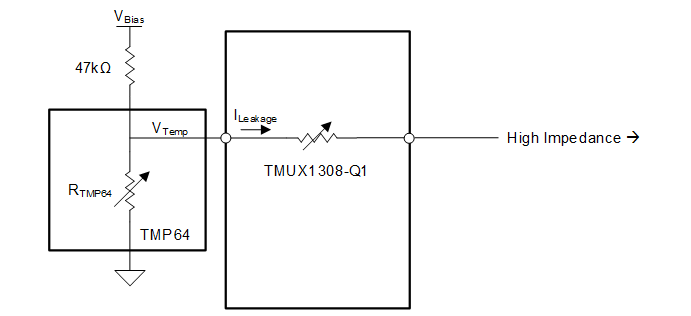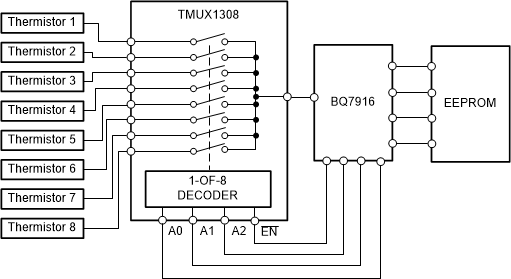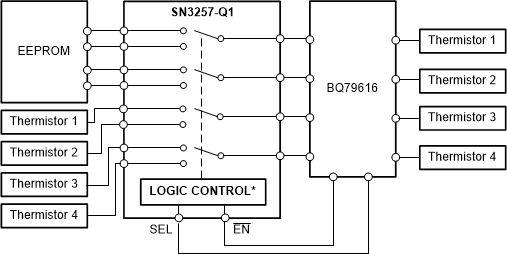SCDA037 September 2021 BQ79616 , BQ79616-Q1 , SN3257-Q1 , TMP64 , TMUX1308 , TMUX1308-Q1 , TMUX1309-Q1
1 Application Brief
Introduction
Battery management systems (BMS) can benefit from additional general-purpose input and output (GPIO) pins on their cell supervision unit (CSU) for the use of monitoring lithium-ion batteries. Lithium-ion batteries, especially in electric vehicles, require the current, voltage, and temperature of the battery cells monitored for the health and safety of the system. In addition to monitoring the battery cells' parameters, the CSU can also use electrically erasable programmable read-only memory (EEPROMs) to store information when the system is off. The information could include system parameters, battery health information, serial numbers, and maintenance records. Unfortunately, monitoring all the data from the battery cells requires a significant amount of the CSU's GPIOs, which prevents the CSU from using an EEPROM or monitoring more battery cells. However, a multiplexer can be used to increase the system functionality without needing to upgrade to a larger CSU. The BQ79616-Q1, a popular BMS CSU, can use the TMUX1308-Q1 8:1 multiplexer to increase its 8 GPIO to 12 GPIO (the configuration is shown in Figure 1-1).
 Figure 1-1 TMUX1308 Multiplexers
Expanding BQ79616 GPIO in a Battery Management System
Figure 1-1 TMUX1308 Multiplexers
Expanding BQ79616 GPIO in a Battery Management SystemFigure 1-1 illustrates the TMUX1308-Q1 expanding the BQ79616-Q1's GPIOs to monitor multiple temperature sensors. The diagram shows using only three GPIOs to control the multiplexer and one GPIO to receive information from the thermistors, eight thermistors are being monitored with only four GPIO.
Signal Chain Performance Impact
When incorporating an additional component such as a multiplexer in the path between the thermistor and CSU, there can often be concerns on how this could impact the overall functionality and performance of the application. The TMUX1308-Q1 (and any other multiplexer) will add resistance and leakage current to the path, but the impact is very minimal, if not undetectable. Normally for this type of application, the thermistor is connected to a high impedance input which will make any series resistance essentially invisible to the signal path since the TMUX1308-Q1 will only be 1700 Ω at most. Leakage is the second concern when implementing a multiplexer, however, is also negligible and shown in Figure 1-2.
 Figure 1-2 TMUX1308-Q1 in Conjunction
Figure 1-2 TMUX1308-Q1 in Conjunction with TMP64
Take the above component diagram using the TMP64 and TMUX1308-Q1 in conjunction. With VBias set to be 5.5 V and the ambient temperature to be 25C, RTMP64 will be approximately 47 kΩ, thus creating a voltage divider where VTemp is equivalent to 2.75 V. Now, taking into consideration the typical leakage current of the TMUX1308-Q1 at 25 C is 1nA and an RON around 230 Ω, this would induce a negligible 230 nV voltage drop (0.0000086% error). However, as the temperature increases to 125 C, RTMP64 is now approximately 80kΩ with a VTemp voltage around 3.45 V. At this temperature and voltage, the RON of the device is now closer to 370Ω with a maximum leakage current of 800 nA. This leads to a voltage drop of 296 uV and a resulting error of 0.00857%.
Overall, it is valid to assume there could be impacts to the signal chain when implementing new components or devices, however the TMUX1308-Q1 is shown to have extremely minimal impact while adding desirable functionality to this application.
Adding EEPROM to Battery Monitor
Battery management systems may improve their battery health and safety by storing critical information in an EEPROM. For example, an EEPROM can store configurations and record the health history of the system. Figure 1-3 shows an EEPROM used in conjunction with the BQ79616-Q1 that is able to monitor eight thermistors using an 8:1 multiplexer.
 Figure 1-3 BQ79616-Q1 in the Whole System
Figure 1-3 BQ79616-Q1 in the Whole System Block Diagram
Typically, an EEPROM interfaces the system using a Serial Peripheral Interface (SPI) consisting of two data lanes, one clock, and a chip select. If the EEPROM were to be connected to the CSU through a multiplexer as in Figure 1-4, a multiplexer selected needs to have a low on-capacitance (CON) to ensure no issue with the SPI data and clock signals.
For example, the SN3257-Q1, a four channel two to one multiplexer, can efficiently and accurately connect an EEPROM and thermistors to a CSU because the SN3257-Q1 has low CON (8 pF) and a low RON (2 Ω). Figure 1-4 illustrates the alternative layout for the BMS using the SN3257-Q1 to connect both the thermistor and EEPROM to the BQ79616-Q1.
 Figure 1-4 SN3257-Q1 in Conjunction with
the BQ79616 and EEPROM
Figure 1-4 SN3257-Q1 in Conjunction with
the BQ79616 and EEPROMSummary
Adding an 8:1 or 4-channel 2:1 multiplexer is an effective way to increase the functionality of a battery management system. The multiplexer can increase CSU's ability to monitor more thermistors or free up additional GPIO that could be used to attach an EEPROM. If the application handles analog signals, such as using a thermistor, having a low multiplexer’s RON helps with accurate readings. If the multiplexer is being used for digital signals, such as with EEPROMS, then having a multiplexer with low CON helps prevent distortion of the rising and falling edges.
| Device | Description |
|---|---|
| TMUX1308-Q1 | Automotive 5-V, 8:1, 1-channel multiplexer with injection current control and 1.8-V logic |
| SN3257-Q1 | Automotive 5-V, 2:1 (SPDT), 4-channel switch with 1.8-V logic and powered-off protection |
| BQ79616-Q1 | 16-S automotive precision battery monitor, balancer and integrated protector with ASIL-D compliance |
| TMP64 | ±1% tolerance 47kΩ linear thermistor available in a 0402-package option |